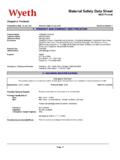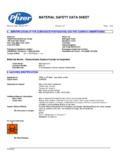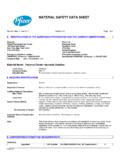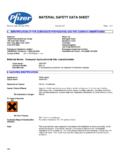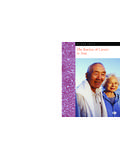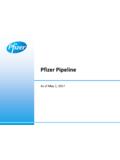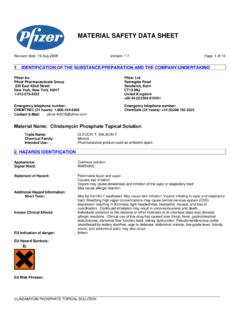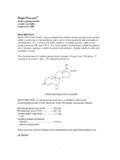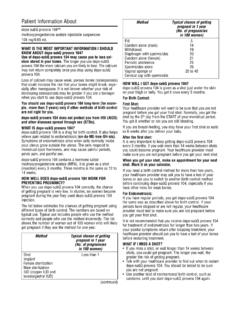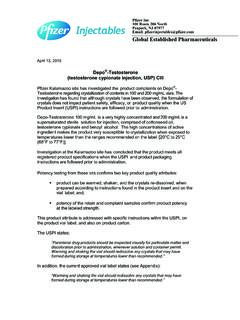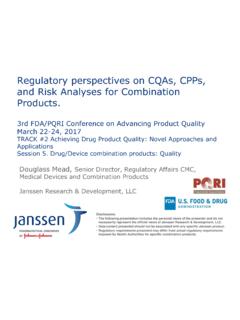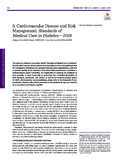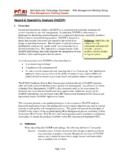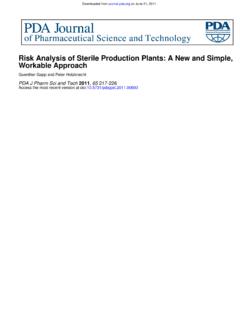Transcription of NARDIL - Pfizer
1 1 NARDIL (Phenelzine Sulfate Tablets, USP)Suicidality and Antidepressant DrugsAntidepressants increased the risk compared to placebo of suicidal thinking and behavior(suicidality) in children, adolescents, and young adults in short-term studies of major depressivedisorder (MDD) and other psychiatric disorders. Anyone considering the use of NARDIL or any other antidepressant in a child, adolescent, or young adult mustbalance this risk with the clinical need. Short-term studies did not show an increase in the riskof suicidality with antidepressants compared to placebo in adults beyond age 24; there was areduction in risk with antidepressants compared to placebo in adults aged 65 and and certain other psychiatric disorders are themselves associated with increases inthe risk of suicide. Patients of all ages who are started on antidepressant therapy should bemonitored appropriately and observed closely for clinical worsening, suicidality, or unusualchanges in behavior.
2 Families and caregivers should be advised of the need for close observationand communication with the prescriber. NARDIL is not approved for use in pediatricpatients. (See Warnings: Clinical Worsening and Suicide Risk, Precautions: Information forPatients, and Precautions: Pediatric Use)DESCRIPTIONNARDIL (phenelzine sulfate) is a potent inhibitor of monoamine oxidase (MAO). Phenelzine sulfate is a hydrazine derivative. It has a molecular weight of and is chemically described as C8 H12 N2 H2SO4. Its chemical structure is shown below:Each NARDIL film-coated tablet for oral administration contains phenelzine sulfate equivalent to 15 mg of phenelzine base and the following inactive ingredients: mannitol, USP; croscarmellose sodium, NF; povidone, USP; edetate disodium, USP; magnesium stearate, NF; isopropyl alcohol, USP; purified water, USP; opadry orange PHARMACOLOGYM onoamine oxidase is a complex enzyme system, widely distributed throughout the body.
3 Drugs that inhibit monoamine oxidase in the laboratory are associated with a number of clinical effects. Thus, it is unknown whether MAO inhibition per se, other pharmacologic actions, or an interaction of both is responsible for the clinical effects observed. Therefore, the physician should become familiar with all the effects produced by drugs of this Following a single 30 mg dose of NARDIL (2 X 15 mg tablets), a mean peak plasma concentration (Cmax) of ng/mL occurred at a time (Tmax) of 43 minutes NARDIL is extensively metabolized, primarily by oxidation via monoamine oxidase. After oral administration of 13C6-phenelzine, 73% of the administered dose was recovered in urine as phenylacetic acid and parahydroxyphenylacetic acid within 96 hours. Acetylation to N2-acetylphenelzine is a minor The mean elimination half-life after a single 30 mg dose is hours.
4 Multiple dose pharmacokinetics have not been studied in man. INDICATIONS AND USAGENARDIL has been found to be effective in depressed patients clinically characterized as atypical, nonendogenous, or neurotic. These patients often have mixed anxiety and depression and phobic or hypochondriacal features. There is less conclusive evidence of its usefulness with severely depressed patients with endogenous should rarely be the first antidepressant drug used. Rather, it is more suitable for use with patients who have failed to respond to the drugs more commonly used for these should not be used in patients who are hypersensitive to the drug or its ingredients, with pheochromocytoma, congestive heart failure, severe renal impairment or renal disease, a history of liver disease, or abnormal liver function potentiation of sympathomimetic substances and related compounds by MAO inhibitors may result in hypertensive crises (see WARNINGS).
5 Therefore, patients being treated with NARDIL should not take sympathomimetic drugs (including amphetamines, cocaine, methylphenidate, dopamine, epinephrine, and norepinephrine) or related compounds (including methyldopa, L-dopa, L-tryptophan, L-tyrosine, and phenylalanine). Hypertensive crises during NARDIL therapy may also be caused by the ingestion of foods with a high concentration of tyramine or dopamine. Therefore, patients being treated with NARDIL should avoid high protein food that has undergone protein breakdown by aging, fermentation, pickling, smoking, or bacterial contamination. Patients should also avoid cheeses (especially aged varieties), pickled herring, beer, wine, liver, yeast extract (including brewer s yeast in large quantities), dry sausage (including Genoa salami, hard salami, pepperoni, and Lebanon bologna), pods of broad beans (fava beans), and yogurt.
6 Excessive amounts of caffeine and chocolate may also cause hypertensive should not be used in combination with dextromethorphan or with CNS depressants such as alcohol and certain narcotics. Excitation, seizures, delirium, hyperpyrexia, circulatory collapse, coma, and death have been reported in patients receiving MAOI therapy who have been given a single dose of meperidine. NARDIL should not be administered together with or in rapid succession to other MAO inhibitors 3because HYPERTENSIVE CRISES and convulsive seizures, fever, marked sweating, excitation, delirium, tremor, coma, and circulatory collapse may use with meperidine is contraindicated (see WARNINGS).A List of MAO Inhibitors by Generic Name Follows:pargyline hydrochloridepargyline hydrochloride and methylclothiazidefurazolidoneisocarboxaz idprocarbazinetranylcypromineNARDIL should also not be used in combination with buspirone HCl, since several cases of elevated blood pressure have been reported in patients taking MAO inhibitors who were then given buspirone HCl.
7 At least 14 days should elapse between the discontinuation of NARDIL and the institution of another antidepressant or buspirone HCl, or the discontinuation of another MAO inhibitor and the institution of have been reports of serious reactions (including hyperthermia, rigidity, myoclonic movements and death) when serotoninergic drugs ( , dexfenfluramine, fluoxetine, fluvoxamine, paroxetine, sertraline, citalopram, venlafaxine) have been combined with an MAO inhibitor. Therefore, the concomitant use of NARDIL with serotoninergic agents is contraindicated (see PRECAUTIONS-Drug Interactions). At least 14 days should elapse between the discontinuation of an MAO inhibitor and the start of a serotonin re-uptake inhibitor or vice-versa, with the exception of fluoxetine. Allow at least five weeks between discontinuation of fluoxetine and initiation of NARDIL and at least 14 days between discontinuation of NARDIL and initiation of fluoxetine, or other serotoninergic agents.
8 Before initiating NARDIL after using other serotoninergic agents, a sufficient amount of time must be allowed for clearance of the serotoninergic agent and its active combination of MAO inhibitors and tryptophan has been reported to cause behavioral and neurologic syndromes including disorientation, confusion, amnesia, delirium, agitation, hypomanic signs, ataxia, myoclonus, hyperreflexia, shivering, ocular oscillations, and Babinski concurrent administration of an MAO inhibitor and bupropion hydrochloride (Wellbutrin ) is contraindicated. At least 14 days should elapse between discontinuation of an MAO inhibitor and initiation of treatment with bupropion taking NARDIL should not undergo elective surgery requiring general anesthesia. Also, they should not be given cocaine or local anesthesia containing sympathomimetic vasoconstrictors.
9 The possible combined hypotensive effects of NARDIL and spinal anesthesia should be kept in mind. NARDIL should be discontinued at least 10 days prior to elective inhibitors, including NARDIL , are contraindicated in patients receiving Worsening and Suicide RiskPatients with major depressive disorder (MDD), both adult and pediatric, may experience worsening of their depression and/or the emergence of suicidal ideation and behavior (suicidality) or unusual changes in behavior, whether or not they are taking antidepressant medications, and this risk may persist until significant remission occurs. Suicide is a known risk of depression and certain other psychiatric disorders, and these disorders themselves are the strongest predictors of suicide. There has been a long-standing concern, however, that antidepressants may have a role in inducing worsening ofdepression and the emergence of suicidality in certain patients during the early phases of treatment.
10 Pooled analyses of short-term placebo-controlled trials of antidepressant drugs (SSRIs and others) showed that these drugs increase the risk of suicidal thinking and behavior (suicidality) in children, adolescents, and young adults (ages 18-24) with major depressive disorder (MDD) and other psychiatric disorders. Short-term studies did not show an increase in the risk of suicidality with antidepressants compared to placebo in adults beyond age 24; there was a reduction with antidepressants compared to placebo in adults aged 65 and pooled analyses of placebo-controlled trials in children and adolescents with MDD, obsessive compulsive disorder (OCD), or other psychiatric disorders included a total of 24 short-term trials of 9 antidepressant drugs in over 4400 patients. The pooled analyses of placebo-controlled trials in adults with MDD or other psychiatric disorders included a total of 295 short-term trials (median duration of 2 months) of 11 antidepressant drugs in over 77,000 patients.
